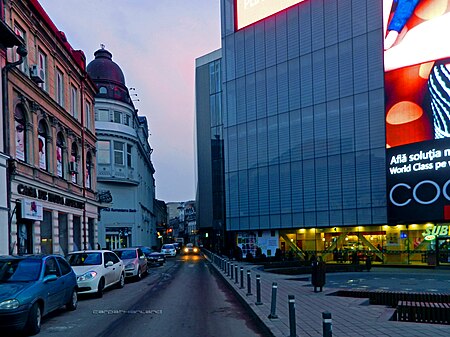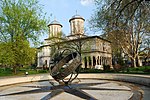Bucharest (UK: BOO-kə-REST, US: -rest; Romanian: București [bukuˈreʃtʲ] (listen)) is the capital and largest city of Romania, as well as its cultural, industrial, and financial centre. It is located in the southeast of the country, on the banks of the Dâmbovița River, less than 60 km (37.3 mi) north of the Danube River and the Bulgarian border.
Bucharest was first mentioned in documents in 1459. It became the capital of Romania in 1862 and is the centre of Romanian media, culture, and art. Its architecture is a mix of historical (mostly Eclectic, but also Neoclassical and Art Nouveau), interbellum (Bauhaus, Art Deco and Romanian Revival architecture), communist era and modern. In the period between the two World Wars, the city's elegant architecture and the sophistication of its elite earned Bucharest the nickname of 'Paris of the East' (Romanian: Parisul Estului) or 'Little Paris' (Romanian: Micul Paris). Although buildings and districts in the historic city centre were heavily damaged or destroyed by war, earthquakes, and even Nicolae Ceaușescu's program of systematization, many survived and have been renovated. In recent years, the city has been experiencing an economic and cultural boom. It is one of the fastest-growing high-tech cities in Europe, according to the Financial Times, CBRE, TechCrunch, and others. UiPath, a global startup founded in Bucharest, has reached over $35 billion in valuation. Since 2019, Bucharest hosts the largest high tech summit in Southeast Europe (Romania Blockchain Summit).In 2016, the historical city centre was listed as 'endangered' by the World Monuments Watch. In 2017, Bucharest was the European city with the highest growth of tourists who stay over night, according to the Mastercard Global Index of Urban Destinations. As for the past two consecutive years, 2018 and 2019, Bucharest ranked as the European destination with the highest potential for development according to the same study.According to the 2011 census, 1,883,425 inhabitants live within the city limits. Adding the satellite towns around the urban area, the proposed metropolitan area of Bucharest would have a population of 2.27 million people. In 2020, the government used 2.5 million people as the basis for pandemic reports. Bucharest is the fourth largest city in the European Union by population within city limits, after Berlin, Madrid, and Rome, just ahead of Paris.
Economically, Bucharest is the most prosperous city in Romania. The city has a number of large convention facilities, educational institutes, cultural venues, traditional 'shopping arcades' and recreational areas.
The city proper is administratively known as the 'Municipality of Bucharest' (Municipiul București), and has the same administrative level as that of a national county, being further subdivided into six sectors, each governed by a local mayor.










